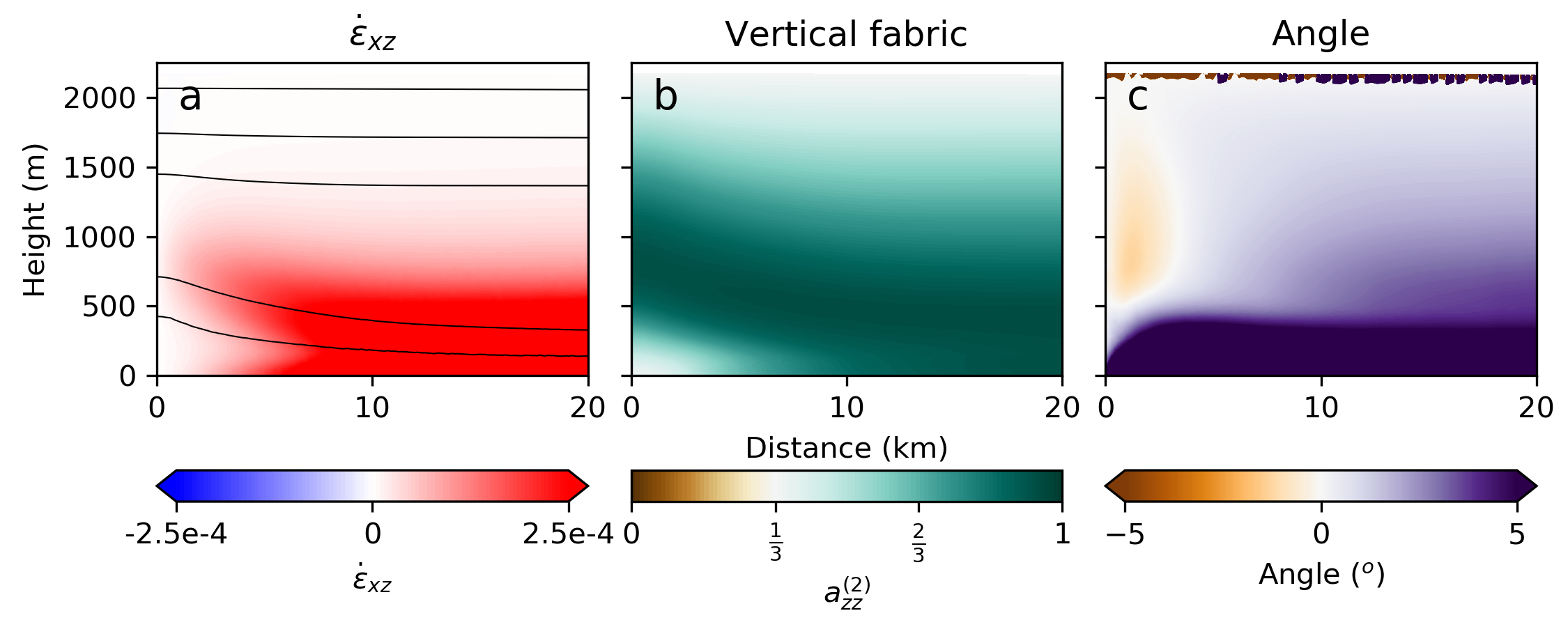Glacier ice is composed of small grains that grow in size with depth in the ice sheet. At the surface, these crystals are randomly oriented, because snow falls in random orientations. Deeper in a glacier, deformation causes these crystals to tend to align in preferred direction, which has some interesting effects on ice flow, and can be measured using radar and seismic waves.
Introduction
Each individual ice crystal has its water molecules bonded in a hexagonal crystal lattice. However, the properties of the crystal are different parallel and perpendicular to this plane. We can thus describe an individual crystal based on the orientation of that axis, termed the c-axis. This orientation is a result of the flow history of that crystal–how it pointed when it fell as snow, how it was squashed, stretched, and rotated with ice flow. This ice crystal fabric affects deformation by making it easier in some directions (think of a deck of cards–two directions of deforming the deck are easy, one is hard).
Motivation
Ice-crystal fabric causes mechanical anisotropy in ice–that is to say, depending on the orientation of the ice crystals, ice flow is easier or harder. Incorporating the effect of this mechanical anisotropy is a key way to make models of ice flow more accurate. Better understanding the effect of fabric on ice flow is the main goal of our fabric-related work.
Fabric basics
Thinking about what happens to an individual crystal is well and good, but if we want to understand how a whole glacier moves we are thinking about an enormous number of crystals, far too many for us to keep track of individually. Instead, we think of a “crystal fabric”, some kind of aggregate of grains that we may be able to describe in relatively simple mathematical terms. Isotropic (randomly oriented), girdle (forming a circle) and single maximum (pointing mainly in one direction) are probably the most common fabric types in ice.
Effect on flow
We can observe fabric using ice cores, radar, or seismics, then consider how that fabric affects flow (generally by using a model). Applying multiple methods to radar data from the Northeast Greenland Ice Stream (NEGIS) has shown that fabric there significantly affects flow. Moreover, we have shown that recent, slow speedup of NEGIS is likely due to fabric development.
In an ice flow model, we seek to approximate how fabric evolves in response to the deformation of ice, and how it affects the deformation of the glacier. Recently, we have been working with a new, small-scale model of ice flow. This work has allowed us to demonstrate that, even though most of us would love to avoid the complications of fabric, fabric really is important for understanding ice-flow properties that people care about, like basal conditions. We have also worked to improve how the modeled fabric is coupled to flow. However, there are lot more areas in which to think about fabric, and it may strongly affect ice flow ways that are not currently considered by the type of ice-flow model used to predict sea-level rise.
Fabric development
Ice divides (ice flows vertically and in one horizontal dimension away from a ridge), or domes (ice flows radially outward from the dome center), are the simplest to think about since the flow fields in these areas are relatively tame. I’ll focus on divides. At divides, the surface has no slope, so there is no shear stress but only downward stress due to gravity, extensional stress away from the divide, and some containing force along the divide. At the divide, the crystal fabric gradually transitions from isotropic (randomly oriented) at the surface to a girdle, or circle in the plane of the divide, due to the extensional stresses. At depth, the ice reaches something of single maximum with crystals pointing upwards, where the vertical stresses dominate. This type of fabric has been seen in ice cores, and models can do a reasonable job reproducing it (see figure below). Just off the divide, we get complex effects as ice is moved around and stress states become more complex. This is seen, for example, in the angle of the fabric which tends to point leftward at certain depths in the right panel of the figure, or in the complex pattern of the shear strain in the left panel. Fabrics are not entirely intuitive, and assessing what fabrics are likely to result from complex deformation regimes is best done with an ice-flow model.

Anisotropic modeling at an ice divide.
One of our groups goals is to get better descriptions of fabric development into ice-flow models. David has worked with implementing the state-of-the-art small-scale physics of fabric in a large-scale model, thus allowing us to understand how fabric develops in situ. However, that work showed that our best models still cannot reproduce observations, so further improvements are needed.
Inferring flow history
A secondary motivation for considering fabric is that it might record past ice flow, a very difficult to observe property. The idea is simple–since the orientation of the grains is affected by flow, they should record how the ice moves. In reality, this is really tricky since multiple types of movement can overprint on each other, and multiple modes of deformation may cause the same fabric. David’s past work has shown that it is possible to infer ice-flow history in theory, and we plan to test it in practice in the future.